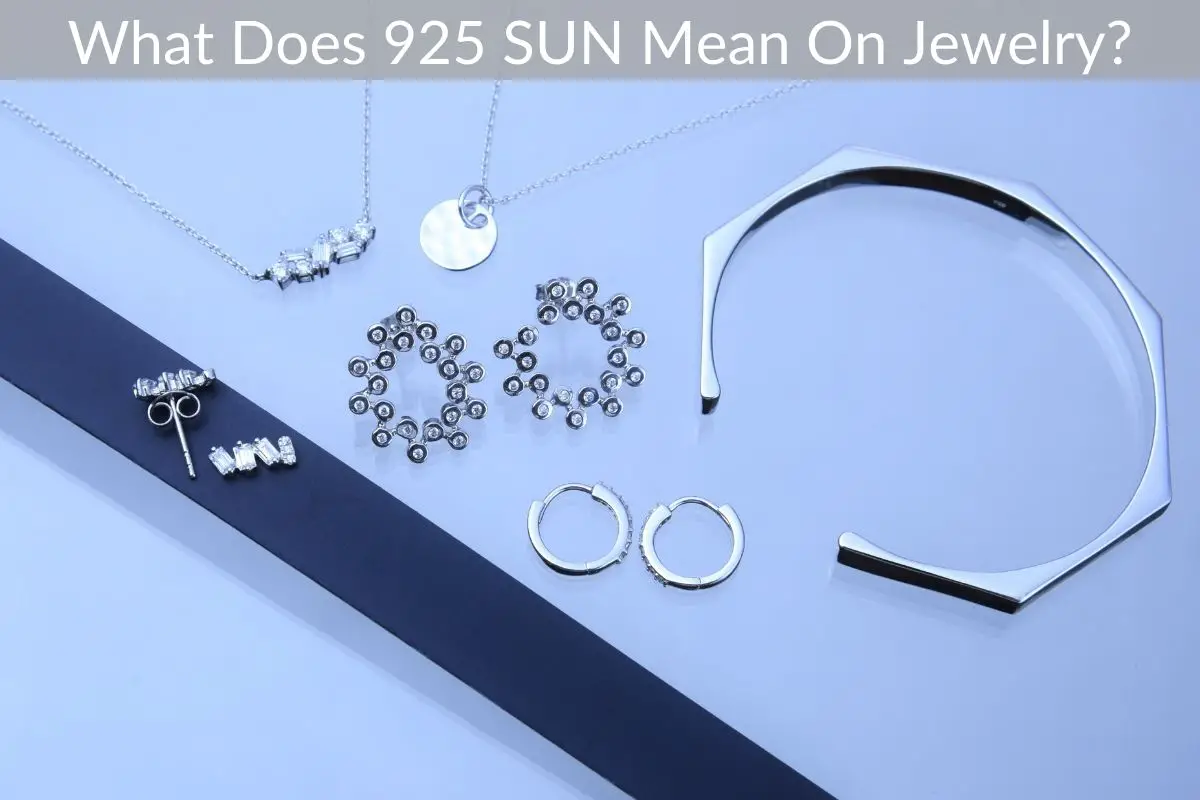Table of Contents
Like gold, silver by itself is too soft to use for jewelry. The purest form of silver used in jewelry is 92.5% silver. The other 7.5% is a mixture of other metals to strengthen the silver. The result is a stronger alloy that can be used for rings, bracelets, necklaces, watches, etc.
*This post may contain affiliate links. As an Amazon Associate we earn from qualifying purchases.
So, if you see .925 stamped onto the piece, that means it is sterling silver.
If your jewelry is stamped with “925 SUN” that indicates the metal is sterling silver and it was probably manufactured by Sun Jewelry, a company that has been selling high-quality jewelry since 1983.
If you see “925 China” stamped on jewelry, that indicates the base of the jewelry is also sterling silver, but it is coated with a thin layer of gold. This type of jewelry is known as gold vermeil (pronounced ver-may) and is a bit more expensive than sterling silver, but not as expensive as solid gold.
Also, keep in mind that the layer of gold in gold vermeil jewelry can rub off with time and wear. To see the most popular sterling silver jewelry just click here.
How Can I Tell If A Diamond Is Real?
Because silver is a soft metal, it cannot withstand the pressure of a large diamond setting. Of course, sterling silver rings with diamonds do exist, but they will most likely have small (melee) diamonds embedded into the silver.
Jewelers usually won’t set a larger, more valuable center diamond in a sterling silver band. Platinum and white gold bands are a better choice than sterling silver when you are shopping for a diamond ring.
So, if you see a diamond ring set in a silver band, that is your first clue that the diamond is fake.
The easiest way to confirm your diamond is authentic is to get it appraised by your local jeweler.
Where Do Diamonds Come From?
Another thing to consider when you’re in the market for a diamond ring is the origin of the diamond. Diamonds are natural resources; they are formed thousands of miles beneath the earth’s surface when carbon deposits are subjected to high temperatures and high pressure.
The process of extracting diamonds from the earth is called diamond mining.
There are three styles of diamond mining. Open-pit and underground mining is usually performed by world-famous mining companies using sophisticated equipment. The third style is alluvial mining, which is done by hand.
There are diamond mines in South Africa, Russia, Australia, India, and Canada. The majority of high quality diamonds are mined in Africa, and have been since 1870.
What Is A ‘Blood Diamond’?
Have you ever heard of the term ‘blood diamond’? If you are not well versed in politics or jewelry, you may only know of the term from the 2006 movie Blood Diamond, starring Leonardo DiCaprio.
Unfortunately, in the 1990s there were three brutal civil wars in Africa. These conflicts took place in Angola, the Democratic Republic of the Congo, and Sierra Leone. Fortunately, the media brought the world’s attention to the fact that rebel groups were selling diamonds to fund their violent campaigns.
The term ‘blood diamond’ was formed by the United Nations to describe any diamond that was mined in areas controlled by forces opposed to the internationally recognized government of a country, and is then sold to fund military action against that government.
They can also be called ‘conflict diamonds’.
Once the public became aware of this issue, diamond traders began to worry that a growing revulsion against blood diamonds might lead to calls for a diamond boycott. So, for financial and political reasons, the Kimberly Process was enacted in 2003. This process created strict guidelines to ensure that ‘conflict diamonds’ do not enter the mainstream diamond market.
For example, rough diamonds have forgery resistant certificates with unique serial numbers and are transported in sealed, tamper resistant containers. Thankfully, the number of ‘blood / conflict diamonds’ on the market today are down to less than 1% as opposed to 15% in 1990.
However, there is still evidence to suggest that workers who mine diamonds by hand are living in poverty and that many of them are under the age of 16 (which is considered child labor).
What If I Can’t Afford A Diamond?
Keep in mind that less than a hundred years ago engagement rings were made with many different colorful gems and precious metals, which resulted in a unique ring for each bride. Your engagement / wedding ring doesn’t have to have diamonds to be beautiful.
If you’d like to avoid diamond jewelry for financial, political, environmental or humanitarian reasons there are a few options available.
The three most common diamond substitutes are cubic zirconia, moissanite, and zircon. When you’re making your choice, you should consider the durability, clarity and color of the stone.
In 1931, Robert M. Shipley standardized the diamond value terms to color, clarity, cut and carat weight, nicknaming them the 4Cs. The same standards can be applied to measuring the value and quality of diamond substitutes.
As the hardest known mineral, diamonds are incredibly durable. Keep in mind, diamond substitutes are less durable than diamonds. Before you buy a ring, you should know how scratch and crack resistant your choice of stone is. This can be done by finding out where the stone is on the Mohs Scale.
In 1812, German mineralogist Friedrich Mohs devised a scale of hardness used in classifying minerals. It runs from 1 to 10 and diamonds are at the top of the list as the most durable mineral.
However, some diamond substitutes are as low as 6.5 on the hardness scale. Here is a great example of Mohs Scale from the National Park Services:
The clarity of a diamond, or diamond substitute, is determined by how clear the stone is. There is also a scale to measure clarity with FL/IF being flawless (referred to as “not included”) and I3 being the most flawed (referred to as “included”).
Here’s a great visualization of the clarity guide from Selecting a Diamond:
The color of a diamond, or diamond substitute, is measured by how colorless it is. Thankfully, like hardness and clarity, there is also a scale to measure color.
The Gia Color Grading Scale begins with D as colorless (best) and goes to Z which is light yellow (worst).
Here is a helpful chart from Shop le Mel.
Here is a brief breakdown of the three diamond alternatives which includes their origin, durability, clarity, and color:
Moissanite
Moissanite is an extremely rare naturally occurring mineral. Therefore, moissanite jewelry is now lab-created. Moissanite has a hardness and sparkle much like diamonds, measuring a 9.25-9.5 on the Mohs scale.
They are created to sparkle more than any other gemstone but may have a yellow or green tint.
Cubic Zirconia
Cubic zirconia is a very rare naturally occurring mineral. Cubic zirconias in jewelry are now the most popular lab-created stones that resemble diamonds. They are an 8 to 8.5 on the Mohs scale, which means they can be scratched, causing dullness over time.
Because they are man-made, they are usually flawless. However, in some cases, there can be cloudiness.
Zircon
Zircon is the oldest mineral found on earth. It appears in many different colors, including colorless. This stone is much softer at a 6 to 7.5 on the Mohs scale, which makes them more prone to cracking and scratching.
Slight impurities and flaws are common (although normally only seen with magnification). Also, when exposed to sunlight or UV light, they may fade or change color.





